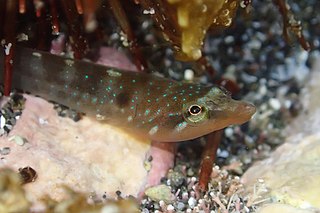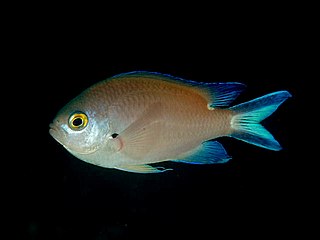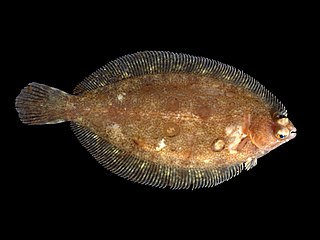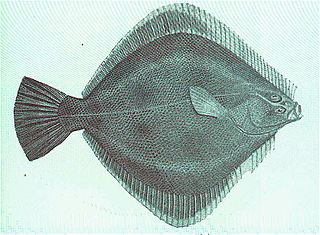
The New Zealand urchin clingfish is a clingfish. It is found around New Zealand wherever sea urchins are present. Its length is between 2 and 3 cm.

Notolabrus fucicola, the banded parrotfish, blue wrasse, kelpie, New Zealand banded wrasse, purple parrotfish, saddled wrasse, Southern purple wrasse, Southern wrasse, winter bream or yellow-saddled wrasse, is a species of wrasse native to the eastern Indian Ocean, off eastern Australia and all around New Zealand on rocky, weedy reef areas. Aging work in New Zealand suggested these wrasses can live at least 35 years.

The Australian ghostshark is a cartilaginous fish (Chondrichthyes) belonging to the subclass Holocephali (chimaera). Sharks, rays and skates are the other members of the cartilaginous fish group and are grouped under the subclass Elasmobranchii. Alternative names include elephant shark, makorepe, whitefish, plough-nose chimaera, or elephant fish. It is found off southern Australia, including Tasmania, and south of East Cape and Kaipara Harbour in New Zealand, at depths of 0–200 m (0–656 ft). Despite several of its names, it is not a shark, but a member of a closely related group.

The banded bellowsfish, banded yellowfish, banded snipefish, or bluebanded bellowsfish, is a species of fish of the family Macroramphosidae, found in southern oceans at depths of 35 to 1,000 m. Its length is up to 30 cm (12 in).

The black flounder, also known by the Māori language name mohoao, is a flatfish of the genus Rhombosolea, found around New Zealand in shallow enclosed waters and coastal freshwater lakes. Its adult length ranges from 20 to 45 cm.
The black ruff is a medusafish, the only member of the genus Centrolophus. It is a pelagic fish found in all tropical and temperate oceans at depths of 0 to 1,000 m. Its length is typically up to 60 cm (24 in), but it may reach 150 cm (60 in). Other common names include rudderfish and blackfish.

The koheru is a ray-finned fish of the genus Decapterus, part of the family Carangidae. It is endemic to New Zealand where it occurs from Manawatāwhi / Three Kings Islands to southern North Island. This is a schooling, pelagic species of coastal waters where it is found within shallow bays, harbours, estuaries and near rocky reefs and offshore islands at depths of between 2 and 90 metres. Juveniles prefer rocky inshore areas, while adults are known to form dense schools in offshore waters. The maximum fork length is 40.3 centimetres (15.9 in). They live to around 10 years and juveniles growth quickly, attaining a fork length of 37 centimetres (15 in) by the time they are three years old. They feed on zooplankton. It is a species of minor interest to commercial fisheries but is taken by recreational anglers.

The North Pacific crestfish or unicornfish is a crestfish of the genus Lophotus, found in the tropical and subtropical waters of the Pacific and Atlantic oceans, in a depth of 0–100 m. Its length is up to 2 m.

The New Zealand sole or common sole, Peltorhamphus novaezeelandiae, is a righteye flounder of the genus Peltorhamphus, found around New Zealand in shallow enclosed waters less than 100 m in depth. Their length is from 25 to 45 cm.

The shortbill spearfish, sometimes called the short-nosed spearfish, is a species of marlin native to the Indian and Pacific Oceans, with occasional records from the Atlantic Ocean. This species occurs in open waters not far from the surface. This species can reach a length of 230 cm (91 in), though most do not exceed 190 cm (75 in). The maximum recorded weight for this species is 52 kg (115 lb). It is of minor importance to commercial fisheries and is also a game fish. Short bill spearfish are characterized by a slim frame with a blue body that is silver underneath. Shortbill also possess a very short bill extending from their upper jaw.

The smokey chromis, also known as the smokey puller or the yellow demoiselle, is a damselfish of the genus Chromis, found in the tropical waters of the eastern Indian Ocean, and the western Pacific Ocean across to north New Zealand, at depths of between 3 and 25 metres, off rocky or coral reef areas. Its length is between 5 and 10 cm.

The New Zealand blueback sprat is a herring-like, forage fish of the family Clupeidae found in the waters around New Zealand, between latitudes 37° S and 48° S, and longitude 166° E and 180° E, to depths of up to 50 m. It belongs to the genus Sprattus, a small oily fish usually known by their common name, sprats. Its length is up to 12 cm.

The lemon sole is a flatfish of the family Pleuronectidae. It is native to shallow seas around Northern Europe, where it lives on stony bottoms down to depths of about 1,400 metres (4,600 ft). It grows up to 65 centimetres (26 in) in length and reaches about 19 kilograms (42 lb) in weight.

The New Zealand sand flounder is a righteye flounder of the genus Rhombosolea, found around New Zealand in shallow waters down to depths of 100 m.

The longnose spurdog is a dogfish shark of the genus Squalus, found over continental shelves in all oceans, at depths of between 15 and 800 metres. They reach one metre in length.

The Lord Howe Island butterflyfish is a butterflyfish of the family Chaetodontidae, found along the east coast of Australia, around Lord Howe Island, and down the east coast of Northland in New Zealand, at depths of between 10 and 150 m. They are up to 20 cm long with black and yellow/white vertical stripes.

The Australasian snapper or silver seabream is a species of porgie found in coastal waters of Australia, Philippines, Indonesia, mainland China, Taiwan, Japan and New Zealand. Its distribution areas in the Northern and Southern Hemispheres are disjunct. Although it is almost universally known in Australia and New Zealand as snapper, it does not belong to the snapper family, Lutjanidae. It is highly prized as an edible fish, with a sweet sea taste and a firm texture.

Idiacanthus atlanticus, the black dragonfish, is a barbeled dragonfish of the family Stomiidae, found circumglobally in southern subtropical and temperate oceans between latitudes 25°S and 60°S, at depths down to 2,000 metres (6,600 ft). The species is sexually dimorphic: females are black with six stripes; males are brown, and lack the females' canine teeth, pelvic fins and barbel. They can weigh between 13-15 grams. Females are believed to make a diel vertical migration from deeper than 500 metres (1,600 ft) by day to surface waters at night, whereas males do not migrate, remaining below 1,000 metres (3,300 ft) at all times.

The pink frogmouth or redeye, Chaunax pictus, is a sea toad of the family Chaunacidae, found around the world on continental shelves in tropical and temperate waters, at depths of between 200 and 660 m. Its length is up to 40 cm. It can be distinguish from present species with a black, deeply concave illicial cavity, and an esca that is black anterodosally and pale or white posteroventrally.

Rhombosoleidae is a family of flatfish in the order Pleuronectiformes, comprising nine genera and 19 species; all members of this family are right eye flounders with asymmetrical pelvic fins. Species are typically demersal, living on bottoms in temperate marine waters on the continental shelf, although some species of Rhombosolea enter fresh water in New Zealand. Most are restricted to waters around Australia and New Zealand, though the Remo flounder, Oncopterus darwinii, occurs in the southwestern Atlantic and the Indonesian ocellated flounder, Psammodiscus ocellatus, occurs in Indonesia.



















